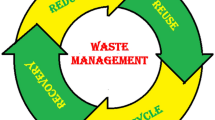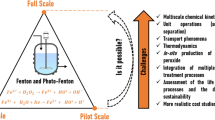Abstract
In this study, the bimetallic Fe/Pd nanoparticle was synthesized using the catalytic element palladium to increase the effect of nano zero valent iron (nZVI), in the light of the information obtained from our previous study, in which the nZVI synthesis method was modified. Dichlorodiphenyltrichloroethane (DDT), one of the most widely used persistent organic pollutant pesticides in the world, was investigated in terms of its degradation by Fe/Pd nanoparticles and the difference with nZVI was determined. During the study, the Fe/Pd concentration, initial DDT concentration, and contact time were selected as variables affecting the treatment. The highest possible initial DDT concentration for the treatment with Fe/Pd bimetallic nanoparticle was investigated to obtain the DDT effluent concentration below the carcinogenesis limit, 0.23 µg/L. The highest concentration that could be treated was found to be 109.95 mg/L with Fe/Pd. It was found that 44.3 min of contact time and 550 mg/L Fe/Pd concentration were needed to achieve this treatment.

Similar content being viewed by others
References
Ayoub G, Ghauch A (2014). Assessment of bimetallic and trimetallic iron-based systems for persulfate activation: Application to sulfamethoxazole degradation. Chemical Engineering Journal, 256: 280–292
Badach H, Nazimek T, Kaminski R, Turski W (2000). Organochlorine pesticides concentration in the drinking water from regions of extensive agriculture in Poland. Annals of Agricultural and Environmental Medicine: AAEM, 7(1): 25–28
Barnes R J, Riba O, Gardner M N, Scott T B, Jackman S A, Thompson I P (2010). Optimization of nano-scale nickel/iron particles for the reduction of high concentration chlorinated aliphatic hydrocarbon solutions. Chemosphere, 79(4): 448–454
Bolognesi C, Merlo F D (2011). Encyclopedia of Environmental Health. Burlington: Elsevier, 438–453
Cakirogullari G C, Secer S (2011). Seasonal variation of organochlorine contaminants in bonito (Sarda sarda L. 1758) and anchovy (Engraulis encrasicolus L. 1758) in Black Sea region, Turkey. Chemosphere, 85(11): 1713–1718
Chen L H, Huang C C, Lien H L (2008). Bimetallic iron-aluminum particles for dechlorination of carbon tetrachloride. Chemosphere, 73(5): 692–697
Chen W F, Pan L, Chen L F, Wang Q, Yan C C (2014). Dechlorination of hexachlorobenzene by nano zero-valent iron/activated carbon composite: Iron loading, kinetics and pathway. RSC Advances, 4: 46689–46696
Clark C J II, Chen X S, Babu S (2005). Degradation of toxaphene by zero-valent iron and bimetallic substrates. Journal of Environmental Engineering, 131(12): 1733–1739
Dong H, Jiang Z, Zhang C, Deng J, Hou K, Cheng Y, Zhang L, Zeng G (2018). Removal of tetracycline by Fe/Ni bimetallic nanoparticles in aqueous solution. Journal of Colloid and Interface Science, 513: 117–125
Dua V K, Kumari R, Johri R K, Ojha V P, Shukla R P, Sharma V P (1998). Organochlorine insecticide residues in water from five lakes of Nainital (U. P.), India. Bulletin of Environmental Contamination and Toxicology, 60(2): 209–215
Elliott D W, Lien H L, Zhang W X (2008). Zerovalent iron nanoparticles for treatment of ground water contaminated by hexachlorocyclohexanes. Journal of Environmental Quality, 37(6): 2192–2201
Elliott D W, Lien H L, Zhang W X (2009). Degradation of lindane by zero-valent iron nanoparticles. Journal of Environmental Engineering, 135(5): 317–324
EPA (2019). Regional Screening Levels (RSLs) - Summary Table (TR= 1E-06, HQ = 1) April 2019. Washington D. C.: USEPA
Erdogrul O, Covaci A, Kurtul N, Schepens P (2004). Levels of organohalogenated persistent pollutants in human milk from Kahramanmaraş region, Turkey. Environment International, 30(5): 659–666
Gao J F, Li H Y, Pan K L, Si C Y (2016). Green synthesis of nanoscale zero-valent iron using a grape seed extract as a stabilizing agent and the application for quick decolorization of azo and anthraquinone dyes. RSC Advances, 6: 22526–22537
He F, Zhao D (2005). Preparation and characterization of a new class of starch-stabilized bimetallic nanoparticles for degradation of chlorinated hydrocarbons in water. Environmental Science & Technology, 39(9): 3314–3320
He F, Zhao D, Liu J, Roberts C B (2007). Stabilization of Fe-Pd nanoparticles with sodium carboxymethyl cellulose for enhanced transport and dechlorination of trichloroethylene in soil and groundwater. Industrial & Engineering Chemistry Research, 46(1): 29–34
Joo S H, Zhao D (2008). Destruction of lindane and atrazine using stabilized iron nanoparticles under aerobic and anaerobic conditions: Effects of catalyst and stabilizer. Chemosphere, 70(3): 418–425
Kalyoncu L, Agca I, Aktumsek A (2009). Some organochlorine pesticide residues in fish species in Konya, Turkey. Chemosphere, 74(7): 885–889
Kolankaya D (2006). Organochlorine pesticide reidues and their toxic effects on the environment and organisms in Turkey. International Journal of Environmental Analytical Chemistry, 86(1–2): 147–160
Liu M, Huang R, Li C, Che M, Su R, Li S, Yu J, Qi W, He Z (2019). Continuous rapid dechlorination of p-chlorophenol by Fe-Pd nanoparticles promoted by procyanidin. Chemical Engineering Science, 201: 121–131
Ozcan S, Tor A, Aydin M E (2011). Levels of organohalogenated pollutants in human milk samples from Konya City, Turkey. CLEAN- Soil, Air, Water, 39(10): 978–983
Qiu X H, Fang Z Q (2010). Degradation of halogenated organic compounds by modified nano zero-valent iron. Huaxue Jinzhan, 22(2–3): 291–297 (in Chinese)
Ravikumar K V G, Singh A S, Sikarwar D, Gopal G, Das B, Mrudula P, Natarajan C, Mukherjee A (2019). Enhanced tetracycline removal by in-situ NiFe nanoparticles coated sand in column reactor. Journal of Environmental Management, 236: 93–99
Sellers K, Mackay C, Bergeson L L, Clough S R, Hoyt M, Chen J, Henry K, Hamblen J (2019). Nanotechnology and the Environment. Boca Raton: CRC Press
Shi Z, Nurmi J T, Tratnyek P G (2011). Effects of nano zero-valent iron on oxidation-reduction potential. Environmental Science & Technology, 45(4): 1586–1592
Shih Y H, Chen Y C, Chen M Y, Tai Y T, Tso C P (2009). Dechlorination of hexachlorobenzene by using nanoscale Fe and nanoscale Pd/Fe bimetallic particles. Colloids and Surfaces A-Physicochemical and Engineering Aspects, 332(2–3): 84–89
Singh R, Singh A, Misra V, Singh R P (2011). Degradation of lindane contaminated soil using zero-valent iron nanoparticles. Journal of Biomedical Nanotechnology, 7(1): 175–176
Stefaniuk M, Oleszczuk P, Ok Y S (2016). Review on nano zerovalent iron (nZVI): From synthesis to environmental applications. Chemical Engineering Journal, 287: 618–632
Tian H, Li J J, Mu Z, Li L D, Hao Z P (2009). Effect of pH on DDT degradation in aqueous solution using bimetallic Ni/Fe nanoparticles. Separation and Purification Technology, 66(1): 84–89
Turgut C, Gokbulut C, Cutright T J (2009). Contents and sources of DDT impurities in dicofol formulations in Turkey. Environmental Science and Pollution Research International, 16(2): 214–217
Ulucan-Altuntas K, Debik E (2017). DDT removal by nano zero valent iron: Influence of pH on removal mechanism. In: Shelly P D M, Ozaslan P D M, eds. ICONTES2017: International Conference on Technology, Engineering and Science. Antalya, Turkey: ISRES Publishing, 339–346
Ulucan-Altuntas K, Debik E (2018). Borohydride method modification in synthesizing nano zero valent iron and its application in DDT removal. Environmental Science and Pollution Research International, 25(30): 30110–30121
Ulucan-Altuntas K, Debik E, Arslan Z B (2019). Dichloro-Diphenyl-Trichloroethane removal via nano zero-valent iron: Determination of degradation mechanism using response surface methodology. Desalination and Water Treatment, 143: 197–207
Vlotman D E, Ngila J C, Ndlovu T, Doyle B, Carleschi E, Malinga S P (2019). Hyperbranched polymer membrane for catalytic degradation of polychlorinated biphenyl-153 (PCB-153) in water. Reactive & Functional Polymers, 136: 44–57
Wang X, Zhu M, Liu H, Ma J, Li F (2013). Modification of Pd-Fe nanoparticles for catalytic dechlorination of 2,4-dichlorophenol. Science of the Total Environment, 449: 157–167
World Health Organisation (WHO) (2004). DDT and its Derivatives in Drinking-water- WHO Guidelines for Drinking-water Quality. Geneva: WHO/SDE/WSH/03.04/89
Yazdanbakhsh A R, Daraei H, Rafiee M, Kamali H (2016). Performance of iron nano particles and bimetallic Ni/Fe nanoparticles in removal of amoxicillin trihydrate from synthetic wastewater. Water Science & Technology, 73(12): 2998–3007
Yohannes Y B, Ikenaka Y, Ito G, Nakayama S M M, Mizukawa H, Wepener V, Smit N J, Van Vuren J H J, Ishizuka M (2017). Assessment of DDT contamination in house rat as a possible bioindicator in DDT-sprayed areas from Ethiopia and South Africa. Environmental Science and Pollution Research, 24: 23763
Zhu N M, Li Y, Zhang F S (2011). Catalytic dechlorination of polychlorinated biphenyls in subcritical water by Ni/Fe nanoparticles. Chemical Engineering Journal, 171(3): 919–925
Acknowledgements
The authors received research grants from the Research Fund of the Yildiz Technical University (No. 2015-05-02-DOP02). Also, Kubra Ulucan-Altuntas was supported by the Scientist Supporting Board of TUBITAK during the study. We would also like to thank Dr. Iberia Aydin and Zumre Busra Arslan for their help.
Author information
Authors and Affiliations
Corresponding author
Additional information
Highlights
• DDT undergoes dechlorination via Fe/Pd bimetallic nanoparticle.
• The oxidation effect of nZVI on DDT is greatly improved when Pd is dopped.
• The highest concentration to be treated under cancerogenesis limit was 110 mg/L.
• The dechlorination of DDT is more like to DDE via Fe/Pd but to DDD via nZVI.
• Degradation products concentrations are lowered via Fe/Pd when compared with nZVI.
Electronic supplementary material
Rights and permissions
About this article
Cite this article
Ulucan-Altuntas, K., Debik, E. Dechlorination of dichlorodiphenyltrichloroethane (DDT) by Fe/Pd bimetallic nanoparticles: Comparison with nZVI, degradation mechanism, and pathways. Front. Environ. Sci. Eng. 14, 17 (2020). https://doi.org/10.1007/s11783-019-1196-2
Received:
Revised:
Accepted:
Published:
DOI: https://doi.org/10.1007/s11783-019-1196-2




